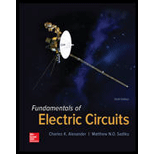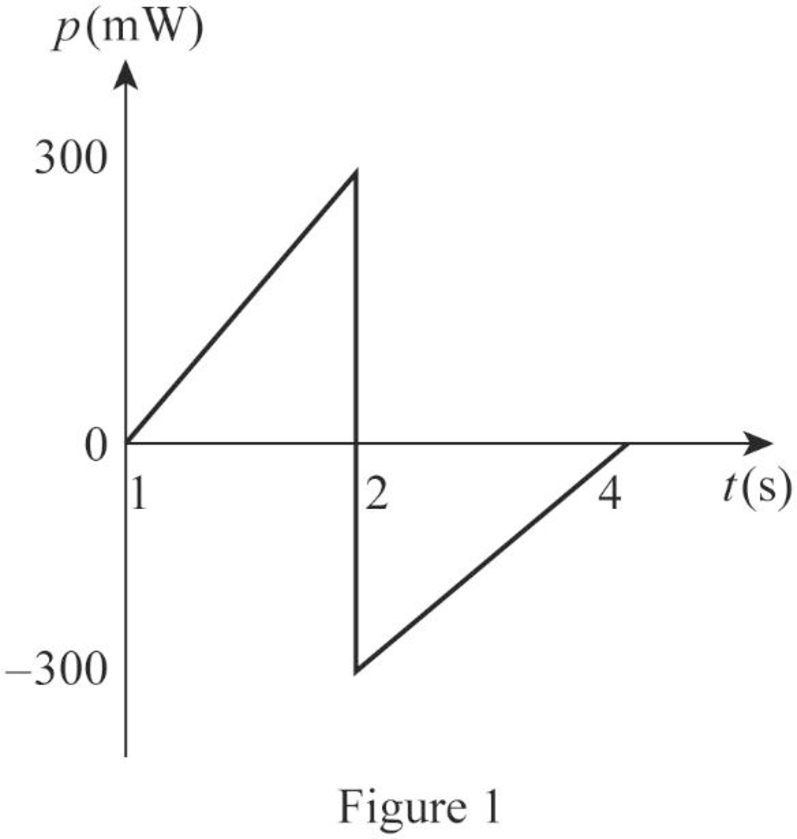
(a)
Sketch the power delivered to the element for
(a)
Explanation of Solution
Given data:
Refer to Figure 1.27 in the textbook for required data.
Formula used:
Write the expression for power delivered to the element as follows:
Here,
Calculation:
From the given current waveform, write the expression for current for 0 to 2 s as follows:
From the given current waveform, substitute
From the given current waveform, write the expression for current for 2 to 4 s as follows:
From the given current waveform, substitute
From the given voltage waveform, write the expression for voltage for 0 to 2 s as follows:
From the given voltage waveform, write the expression for voltage for 2 to 4 s as follows:
Modify the expression in Equation (1) for the power delivered to the element for 0 to 2 s as follows:
Substitute 5 V for
Modify the expression in Equation (1) for the power delivered to the element for 2 to 4 s as follows:
Substitute
From the calculation, write the expression for power delivered to the element as follows:
From the expression of power, draw the waveform for power delivered to the element as shown in Figure 1:

Conclusion:
Thus, the waveform for power delivered to the element is sketched.
(b)
Find the amount of energy absorbed by the element for the period of
(b)
Answer to Problem 16P
The amount of energy absorbed by the element for the period of
Explanation of Solution
Formula used:
Write the expression for energy as follows:
Here,
Calculation:
From Part (b), the expression for power delivered to the element is written as follows:
Substitute 0 s for
Rewrite the expression as follows:
Substitute
Simplify the expression as follows:
Conclusion:
Thus, the amount of energy absorbed by the element for the period of
Want to see more full solutions like this?
Chapter 1 Solutions
Fundamentals of Electric Circuits
- Please solve this question step by step handwritten solution and do not use ai or chat gpt pleasearrow_forward".I need the correct answers with explanations" Q1: What is the orientation of voltage regulation value (positive or negative) of alternator loaded by capacitive load? Explain the effect of armature reaction on voltage regulation for this load? Draw the load characteristics of alternator for capacitive, inductive, and inductive loads? Q2: A 2000 kVA,2200 V, 60 Hz,Y-connected alternator has a resistance of 0.25 between each pair of terminal. A field current of 80 A produces a short circuit current equal to full load current in each line. The same field current produces an e.m.f of 800 V(L-L) on open circuit .Determine the full load voltage regulation of alternator at unity p.f?arrow_forward12. If the length of a transmission line increases, its inductance is B. decreases C. Constant D. None of them A. increases 13. When the regulation is negative, then receiving end voltage (VR) is.......... than sending and voltage (VS). B. More C. Equal A. Less D. None of the them 10. If the spacing between the conductors is decrease, the inductance of the line will be: A. Increase B. decreases C. Not effected D. Non of them 6. Cables have more effective in... A. Inductance B. Capacitance than over head transmission lines C. Resistance D. All of the abov 7. By which of the following methods string efficiency can be equa! 100% A. Using a guard ring B. Equal insulator voltage C. Using long cross arm D.Non of them Power system Prove answerarrow_forward
- ".I need the correct answers with explanations" A power station has a daily load cycle as under: 260 kwh for 6 hours; 200 kwh for 8 hours: 160 kwh for 4 hours, 100 kwh for 6 hours. If the power station is equipped with 4 units of 75 kw each, calculate (i) daily load factor (ii) plant capacity factor and (iii) daily requirement of fuel in kg if the calorific value of fuel used were 10,000 kcal/kg.arrow_forward"I need the correct answers with explanations" Pick up the correct answer 1. The area under the daily load curve gives A. average load in kw B. units generated in kwh 2. the minimum phase-neutral voltage at which corona A. Visual critical voltage B. Receiving voltage C. plant capacity in kw D. Maximum demand in kw occurs is C. String voltage D. Critical disruptive voltage. 3. If the length of a transmission line increases, its inductance is B. Decreases C. Constant A. Increases 4. Photo cells are connected in parallel in order to D. None of them A. Increase voltage rating B. Increase current rating C. Increase life cells. D. All of the them 5. Which of the following is a high head turbine? A. Pelton turbine B. Francis turbine 6. Best diversity factor will be at: C. Kaplan turbine D. Propeller turbine A. diversity factor 1 7. When the voltage regulation is positive, then receiving voltage is ...... than sending voltage A. Less B. More C. Equal D. None of the them 8. Fill factor of solar…arrow_forwardConsider the system shown in Fig. Q4(b). Draw a Bode diagram of the open-loop transfer function, and determine the value of the gain K such that the phase margin is 50° . Also, obtain the gain margin of the system with the determined value of gainarrow_forward
- ".I need the correct answers with explanations" Answer True or False and correct errors if found 1. In a certain Op-Amp. if Ad-3500, Ac-0.35, the CMRR=100dB. 2. The voltage series feedback can increase both input and output impedances. 3. A two-pole Sallen-Key high-pass filter contains one capacitor and two resistors. 4. The main feature of a crystal oscillator is the high frequency operation. Each transistor in a class B power amplifier conducts for the entire input cycle. The Q-point must be centered on the load line for maximum class A output signal swing. 7. The differentiator Op-Amp can convert the triangle waveform into sinewave. Class AB power amplifier eliminates crossover distortion found in pure class A. 9. Wien-bridge oscillators are based on positive feedback circuits. 10. The band-reject filter is composed of multiplication of LPF and HPF.arrow_forward".I need the correct answers with explanations" Pick up the correct answer 1. Station that contain boiler is: A. hydro station B. Diesel station 2. Taking into account cost, most of the D. All of them C. Steam power station high-voltage transmission lines are OC. Either of the above D. None of the ab 3. If the maximum load is equal to plant capacity. The plant capacity factor is: A. Underground. B. Overhead C. >1 D. <1 A. 1 4. Five photocells are connected in parallel, 2V for each cell. The output voltage is A.2.5 V B. zero B. 10 V C.2V) D. 5 V 5. Sum of continuous ratings of all the equipment connected to electric power system is defined as: A. Maximum demand B. Connected load C. Daily average load D. Load variation 6. Cables have more effective in.............. than over head transmission lines B. Capacitance C. Resistance D. All of the abov A. Inductance 7. By which of the following methods string efficiency can be equal. 100% A. Using a guard ring B. Equal insulator voltage C.…arrow_forwardQ3/A unity-feedback system with the forward transfer function G(S)= K S(S+7) is operating with a closed-loop step response that has 15% overshoot. Do the following: a. Evaluate the steady-state error for a unit ramp input. b. Design a lag compensator to improve the steady-state error by a factor of 20 to get a new dominant closed-loop poles S-3.4+ j5.63. place the pole of the lag compensator at s=-0.01 c. Design a lag compensator using OP amp if R1= 100KS2 R2=10 KS2 and R3= 10Karrow_forward
 Introductory Circuit Analysis (13th Edition)Electrical EngineeringISBN:9780133923605Author:Robert L. BoylestadPublisher:PEARSON
Introductory Circuit Analysis (13th Edition)Electrical EngineeringISBN:9780133923605Author:Robert L. BoylestadPublisher:PEARSON Delmar's Standard Textbook Of ElectricityElectrical EngineeringISBN:9781337900348Author:Stephen L. HermanPublisher:Cengage Learning
Delmar's Standard Textbook Of ElectricityElectrical EngineeringISBN:9781337900348Author:Stephen L. HermanPublisher:Cengage Learning Programmable Logic ControllersElectrical EngineeringISBN:9780073373843Author:Frank D. PetruzellaPublisher:McGraw-Hill Education
Programmable Logic ControllersElectrical EngineeringISBN:9780073373843Author:Frank D. PetruzellaPublisher:McGraw-Hill Education Fundamentals of Electric CircuitsElectrical EngineeringISBN:9780078028229Author:Charles K Alexander, Matthew SadikuPublisher:McGraw-Hill Education
Fundamentals of Electric CircuitsElectrical EngineeringISBN:9780078028229Author:Charles K Alexander, Matthew SadikuPublisher:McGraw-Hill Education Electric Circuits. (11th Edition)Electrical EngineeringISBN:9780134746968Author:James W. Nilsson, Susan RiedelPublisher:PEARSON
Electric Circuits. (11th Edition)Electrical EngineeringISBN:9780134746968Author:James W. Nilsson, Susan RiedelPublisher:PEARSON Engineering ElectromagneticsElectrical EngineeringISBN:9780078028151Author:Hayt, William H. (william Hart), Jr, BUCK, John A.Publisher:Mcgraw-hill Education,
Engineering ElectromagneticsElectrical EngineeringISBN:9780078028151Author:Hayt, William H. (william Hart), Jr, BUCK, John A.Publisher:Mcgraw-hill Education,





